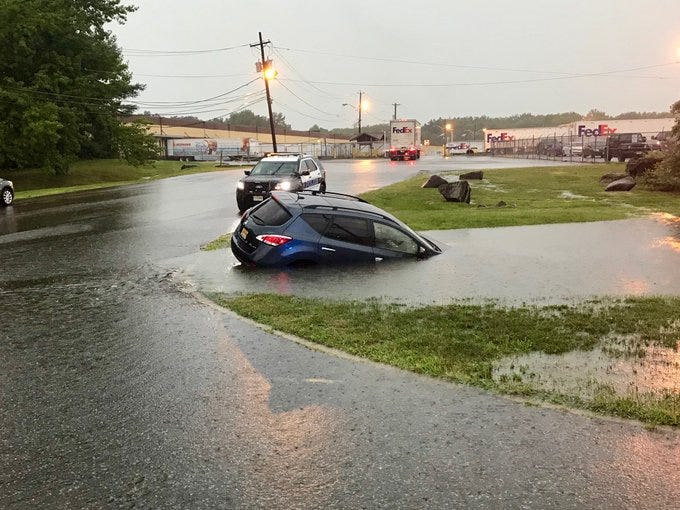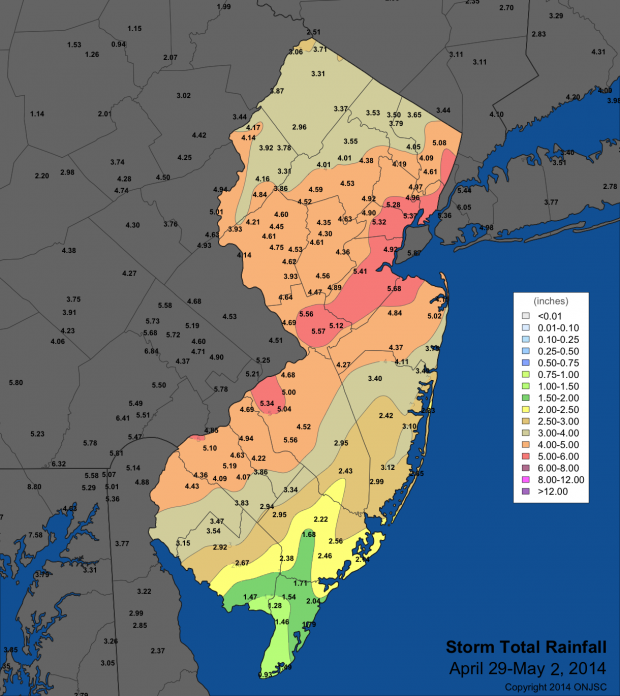

During 2010–2014, the state experienced the greatest number of 2-inch extreme precipitation events, about 50% above the long-term average. The number of 2-inch extreme precipitation events was well above average during 2005–2014 but has been slightly below average since then (Figure 4). The wettest consecutive 5 years was the 1971–1975 interval, and the driest was the 1962–1966 interval. The driest conditions were in the 1960s, and near normal to wet conditions have occurred since the 1970s. Total annual precipitation for New Jersey has been about 3.7 inches above average over the last 16 years (Figure 2c). During the 2000–2020 interval, there were no top 5 coldest months, but there were 38 top 5 warmest months. Over the past 25 years, there have been many more unusually warm months than unusually cold months in New Jersey. The number of very cold nights has been below average since the early 1990s (Figure 2b). The number of warm nights in New Jersey has consistently been above the long-term average since the early 2000s, with the highest 5-year average occurring during the 2010–2014 period (Figure 3). The number of very hot days has been varied (Figure 2a). The year 2012 was the warmest on record at 3.0☏ above average, and 2020 was the second warmest on record at 2.6☏ above average. All of the 10 hottest calendar years on record for the state have occurred since 1990, and six have occurred since 2010. Temperatures in New Jersey have risen more than 3.5☏ since the beginning of the 20th century (Figure 1). There is a north-south precipitation gradient as well, with the north-central portion of the state averaging around 50 inches of precipitation and the coastal region averaging 40–45 inches. The statewide annual average precipitation is 47.6 inches. A similar temperature gradient exists for average maximum temperatures in July-cooler summertime temperatures of 80° to 85☏ occur in the northwestern corner and temperatures between 85° and 90☏ occur in the rest of the state. Average minimum temperatures in January range from 15° to 20☏ in the northwest to 25° to 30☏ along the coast. The northern elevated highlands and valleys experience colder temperatures and more annual average precipitation than the rest of the state.

Temperature differences from the northwest to southeast are most noticeable in the winter. There is a west-to-east contrast of temperatures, with cooler temperatures in the higher elevations of the northwest and warmer temperatures in the east near the coast.

As a result of these influences, New Jersey’s climate is characterized by moderately cold and occasionally snowy winters and warm, humid summers. In winter, the contrast between the frigid air masses of the continental interior and the relatively warm Atlantic provides the energy for occasional intense storms known as nor’easters. In addition, New Jersey’s location on the eastern coast of North America exposes it to the cold winter and warm summer air masses of the continental interior and the moderate and moist air masses of the western Atlantic Ocean. Precipitation is frequent because low-pressure storms associated with the jet stream commonly affect the state. New Jersey’s geographic position in the mid-latitudes often places it near the jet stream, particularly in the late fall, winter, and spring, giving the state its characteristic varied weather. Less warming is expected under a lower emissions future (the coldest end-of-century projections being about 2☏ warmer than the historical average green shading) and more warming under a higher emissions future (the hottest end-of-century projections being about 9☏ warmer than the hottest year in the historical record red shading). Historically unprecedented warming is projected during this century. Observed temperatures are generally within the envelope of model simulations of the historical period (gray shading). Shading indicates the range of annual temperatures from the set of models. Temperatures in New Jersey (orange line) have risen more than 3.5☏ since the beginning of the 20th century. Projected changes for 2006–2100 are from global climate models for two possible futures: one in which greenhouse gas emissions continue to increase (higher emissions) and another in which greenhouse gas emissions increase at a slower rate (lower emissions). Figure 1: Observed and projected changes (compared to the 1901–1960 average) in near-surface air temperature for New Jersey.


 0 kommentar(er)
0 kommentar(er)
